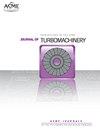The Application of Fluidic Sealing in Shrouded Gas Turbine Blades
IF 3.1
3区 工程技术
Q3 ENGINEERING, MECHANICAL
引用次数: 0
Abstract
Abstract This paper presents a study conducted on a new gas turbine, designed to limit leakage in the labyrinth seal. The slots in the fin are used to generate a bypass flow, which obstructs the flow in the gap above the fin. The method was tested numerically and experimentally beforehand using a simplified model without rotation or blade passages. In this paper, the validation of the method using a model of a turbine stage is shown. RANS simulations using two turbulence models – Spalart-Allmaras (SA) and k-ω EARSM were conducted. Comparisons of leakage flow and stage efficiency for reference and fluidic sealing configurations are presented. Fluidic sealing configuration is effective and reduces the leakage flow by 13-18.5% (depending on the turbulence model). The analysis of the flow structure in the seal region revealed, that the use of fluidic sealing resulted in significant circumferential flow anisotropy.流体密封在带冠燃气轮机叶片中的应用
摘要本文对一种新型燃气轮机进行了篦齿密封泄漏限制研究。在此之前,采用简化模型对该方法进行了数值和实验验证,该模型不考虑旋转和叶片通道。本文以某涡轮级为例,对该方法进行了验证。采用Spalart-Allmaras (SA)和k-ω EARSM两种湍流模型进行了RANS模拟。比较了参考型和流体密封型的泄漏流量和级效率。流体密封配置是有效的,减少泄漏流量13-18.5%(取决于湍流模型)。对密封区域流动结构的分析表明,流体密封的使用导致了明显的周向流动各向异性。
本文章由计算机程序翻译,如有差异,请以英文原文为准。
求助全文
约1分钟内获得全文
求助全文
来源期刊
CiteScore
4.70
自引率
11.80%
发文量
168
审稿时长
9 months
期刊介绍:
The Journal of Turbomachinery publishes archival-quality, peer-reviewed technical papers that advance the state-of-the-art of turbomachinery technology related to gas turbine engines. The broad scope of the subject matter includes the fluid dynamics, heat transfer, and aeromechanics technology associated with the design, analysis, modeling, testing, and performance of turbomachinery. Emphasis is placed on gas-path technologies associated with axial compressors, centrifugal compressors, and turbines.
Topics: Aerodynamic design, analysis, and test of compressor and turbine blading; Compressor stall, surge, and operability issues; Heat transfer phenomena and film cooling design, analysis, and testing in turbines; Aeromechanical instabilities; Computational fluid dynamics (CFD) applied to turbomachinery, boundary layer development, measurement techniques, and cavity and leaking flows.

 求助内容:
求助内容: 应助结果提醒方式:
应助结果提醒方式:


